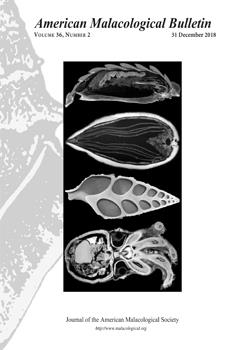Petra Sierwald, Rüdiger Bieler, Elizabeth K. Shea, Gary Rosenberg
American Malacological Bulletin 36 (2), 177-214, (1 December 2018) https://doi.org/10.4003/006.036.0202

KEYWORDS: biodiversity, collection management, databases, digitization, Mollusca
In 2017, a minimum of 8.5 million mollusk lots representing some 100 million specimens were held by 86 natural history collections in the U.S. (81) and Canada (5). Of these, 6.2 million lots representing 70 million specimens were cataloged (73%), another 2.3 million lots were considered quality backlog awaiting cataloguing, and 4.5 million lots (53% of the total) had undergone some form of data digitization. About 1.1 million (25%) of the digitized lots have been georeferenced, albeit with different approaches to accuracy and uncertainty. Fewer than 25% of collections, mainly larger ones, claim to be fully Darwin Core compliant. There are 35,000 primary type lots and 66,000 secondary type lots, representing 1.6% of cataloged lots. About 87% of lots are dry and 13% are fluid preserved, with less than 0.3% frozen. The majority of lots are gastropods (71%) and bivalves (26%). By habitat, 54% of lots are marine, 26% terrestrial, 19% freshwater, and 1% brackish. About 43% of marine and 57% of non-marine holdings are from North America including the Caribbean.
Solem (1975), in a previous survey of U.S. and Canadian malacological collections, reported 3.74 million lots of which 775,000 (21%) were uncataloged backlog, and suggested that backlog was growing at a faster rate than specimens were being cataloged. Since then the overall size of mollusk collections has grown by 227% and cataloged lots by 208%, but quality backlog has grown by 300%, confi rming Solem's extrapolation. Solem noted that the eight largest collections held 78% of the lots, but in 2017 the eight largest (now with a slightly different composition) held only 63.5% of the lots, refl ecting substantial growth of small and mid-sized collections, and the larger number of institutions that we surveyed. Solem reported a substantial gap between large collections (≥160,000 lots; AMNH, ANSP, BPBM, DMNH, FMNH, LACM, MCZ, UF, UMMZ, USNM) and mid-sized ones (35,000-75,000 lots; ChM, FWRI, Hefner, HMNS, SDNH, NCSM, SIOBIC, UCM, UWBM, YPM), but seven collections now fall in the range of 76,000 to 160,000 (CM, BMSM, CASIZ, CMNML, INHS, OSUM, and SBMNH), and two have jumped to the large category (UF and DMNH).
Often overlooked is Solem's conclusion that mollusk collections in the United States and Canada are second only to insect collections for number of specimens, which is still true. Because there are far fewer species of mollusks than insects, mollusks have more specimens per species, averaging 1,100 in our survey, almost ten times what Solem reported for insects and approaching what he reported for fish. Bivalvia may have as many as 2,400 specimens/species, which makes them among the best-sampled classes of metazoans. The high number of specimens/species among mollusk and fish collection makes them well-suited for environmental studies that track faunal change over time and space.


